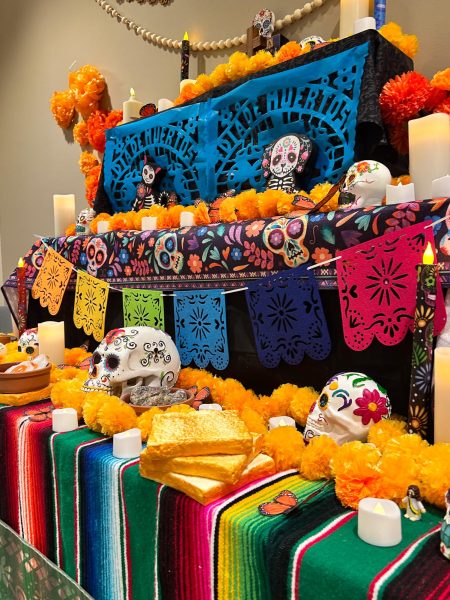Residence Life and Housing at Colorado State University Pueblo is hosting their second annual Día de los Muertos Celebration on October 30 from 5-9pm. In addition, there will be a performance taking place from 6-8pm in Hoag Hall. This extravaganza seeks to honor Latino heritage and culture. It is a family-friendly event open to the public and invites attendees to honor loved ones who have passed while appreciating those who are still with us.
The Importance of Día De Los Muertos to the CSU Pueblo Community
Reporter Gio Alfonso had a chance to sit down with Perla Ramirez–a Business Administration and Marketing student at CSU Pueblo who is also the current Marketing and Desk Coordinator in the Residence Life and Housing department–to discuss the importance of Día de los Muertos.
This is the second year that housing is throwing a Día De Los Muertos celebration, “getting away from a traditional Halloween celebration,” said Ramirez, in a way that is “bringing a bit of culture and tradition to campus.” This is a community event and anyone is welcome to come, with entry being free for students of CSU Pueblo. She also stated the only thing you need to bring is yourself.
When asked what the holiday means to her personally, Ramirez said “I definitely grew up talking about the Day of the Dead but not really celebrating due to not many passings within my family. But this year will be one of the first due to the passing of my grandfather.” Noting the true significance of Dia de los Muertos, she added, “many people, including me and my own, will go to church to pray for all souls.”
This event seeks to bring that opportunity to the campus community, offering a chance for attendees to celebrate the cultural holiday in the residence halls–remembering their loved ones with different people while being surrounded by family and friends they love dearly.
Ramirez said that for those that are with us, this event creates space for “learning more about what the holiday is and what it is about and being able to build your own altar.”
“Life is celebrated even with those who have passed on.” – Perla Ramirez
Ramirez is looking forward to the altar competition, seeing the different altars from across campus and the community. She is also looking forward to sharing pan de muerto, a very sweet bread.
For people who cannot attend the event, there are still ways to recognize Dia de los Muertos and to honor their loved ones who have passed on.

Below are recommendations for building an ofrenda, a traditional altar that is a crucial part of celebrating the Day of the Dead (courtesy of Chicano Studies at CSU Pueblo).
The most important thing to place on your Day of the Dead altar is a photograph of the person(s) to whom you are dedicating the altar.
The three tier altar is covered in papel picado – which is bright colored tissue paper with cut out designs. The paper can be either handmade or purchased. Three important colors are purple (for pain) white (for hope) and pink (for the celebration).
Candles are also placed all over the altar. Purple candles again are used to signify pain. On the top level of the altar, four candles need to be placed – signifying the four cardinal points. The light of the candle will illuminate the way for the dead upon their return.
Three candy skulls are placed on the second level. These represent the Holy Trinity. On the center of the third level a large skull is placed – this represents the Giver of Life.
All bad spirits must be whisked away and leave a clear path for the dead soul by burning in a bracero, a small burner used to cook outside. Or you can use a sahumerio to burn copal or incense. A small cross of ash is made so that the ghost will expel all its guilt when it is stepped on.
The Day of the Dead bread, pan de muerto, should be accompanied by fruit and candy placed on the altar. Thepan de muerto is plain round sweet bread sprinkled with white sugar and a crisscrossed bone shape on top. Pan de muerto is available in Mexican food stores and bakeries in Pueblo. You can also add the person’s favorite food.
A towel, soap and small bowl are put on the altar so that the returning souls can wash their hands after their long trip. There is a pitcher of fresh water to quench their thirst and a bottle of liquor to remember the good times of their life.
To decorate and leave a fragrance on the altar, the traditional cempasuchil flower is placed around the other figures. Cempasuchil comes from Nahuatl cempoalxochitl, or the flower with four hundred lives. The flower petals form a path for the spirits to bring them to their banquet.